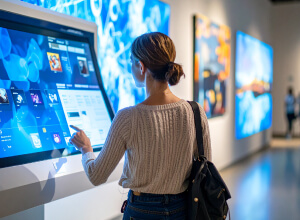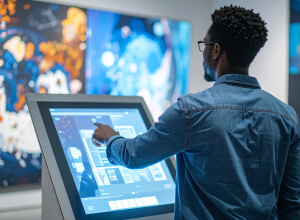5 DOs and 5 DON'Ts of Interactive Digital Signage

Interactive digital signage is a powerful tool for engaging customers with immersive experiences, but success hinges on careful strategy. This blog outlines five key DOs and DON’Ts to optimize effectiveness. DOs include prioritizing privacy, using no-code software for customization, and understanding your audience, while DON’Ts warn against neglecting analytics, relying on a centralized CMS, and overcomplicating content. By following these guidelines, businesses can enhance customer engagement, create seamless experiences, and leverage signage to build strong brand connections.
Interactive digital signage has become an essential tool for businesses aiming to engage customers with immersive, two-way communication. However, success with interactive signage requires strategic planning and mindful execution to avoid common pitfalls. Below are the top five DOs and DON’Ts to ensure your digital signage delivers maximum impact and a seamless customer experience.
5 DON'Ts of Interactive Digital Signage
1. Don't Ignore Analytics (when it comes to your digital signage performance)
Interactive digital signage isn’t just about displaying content; it’s about engaging users and tracking these interactions. Leveraging analytics is essential for gathering insights into user behavior, refining content, and making data-driven decisions to improve performance. Analytics enable you to measure how effectively your signage captivates and retains attention, enabling you to adapt based on real data. Without analytics, interactive signage loses its full potential as an engagement tool.
Key Considerations:
- Choose digital signage software with robust analytics.
- Track metrics like engagement time, content selection, peak usage times and highest traffic locations.
- Use analytics to inform content updates and overall strategy.
2. Don't Use a Centralized Content Management System (CMS)
A centralized CMS can restrict the flexibility of your signage. Most traditional CMS platforms lack integration capabilities and can become isolated systems unable to connect with external resources. Opt for a platform that enables API integration, real-time connectivity to external resources, and support for offline use. This flexibility allows you to avoid slow updates and offers seamless collaboration across teams.
Drawbacks of a Centralized CMS:
- Limited access to real-time data
- Difficulties with scaling and updates
- Reduced interactivity and customization options
3. Don't Settle for Predefined Templates

Using standard templates may seem convenient, but it limits creativity and the personalization of your digital signage. Predefined templates can be restrictive, lacking the flexibility to reflect your brand’s unique identity or adapt to specific audience needs. Instead, choose digital signage software that permits full customization, enabling you to develop layouts that resonate with your brand and audience.
Tips for Customization:
- Use your brand colors, fonts, and imagery to reinforce brand identity.
- Customize layouts to match your specific content strategy.
- Prioritize dynamic and flexible design elements that can be adapted for seasonal promotions or campaigns
4. Don't Overcomplicate Content
The average viewer has limited attention, so keep your content straightforward and intuitive. Overloading interactive signage with excessive text or complex animations can overwhelm users. Simplify navigation and visuals to convey messages clearly within seconds. This minimalistic approach keeps viewers engaged and enhances their experience.
Best Practices for Simplicity:
- Limit text and focus on impactful visuals.
- Use large, clear icons and buttons for easy navigation.
- Avoid excessive animations that may distract from key messaging.
5. Don't Operate in Isolation - utilize digital signage collaboration
Collaboration is essential when designing interactive digital signage, especially for multi-location installations or collaborative content projects. A collaborative approach allows input from team members with varying expertise, resulting in better-aligned, user-focused content. By involving stakeholders, you ensure the signage aligns with marketing, technical, and brand standards.
Collaboration Tips:
- Use naming conventions that make files easily recognizable for all team members.
- Implement digital signage software that allows easy sharing and remote access.
- Schedule regular feedback loops to incorporate insights from stakeholders.
5 DOs of Interactive Digital Signage
1. Do Prioritize User Privacy
Interactive digital signage often gathers user data, making it essential to maintain transparency and protect user privacy. As advised by regulations like GDPR, inform users of any data collection practices, and ensure they understand how their information is used. Additionally, consider signage placement and user interface design to help users feel secure and comfortable during interactions.
Privacy Best Practices:
- Place signage at an appropriate height and angle for privacy.
- Use secure methods for data storage and transmission.
- Clearly communicate data collection policies and offer opt-out options.
2. Do use No-Code Software for Customization
For non-developers, creating interactive signage using no-code software simplifies the design process, reducing the need for specialized programming skills. No-code digital signage software like Intuiface enables rapid prototyping and flexibility for teams to adjust content without extensive coding knowledge. This approach helps businesses scale their signage effectively while maintaining design control and adaptability.
Advantages of No-Code Software:
- Faster turn around time for content updates
- Greater flexibility to adjust designs based on feedback
- Reduced costs and dependency on developers
3. Do Go Beyond Touch Interactions
Touch interactions are valuable, but modern users expect more. By integrating additional forms of interaction—such as voice commands, motion sensors, or object recognition—you broaden accessibility and engagement. These added layers of interaction make your signage inclusive and offer users a richer, multi-dimensional experience.
Interactive Options to Consider:
- Voice commands for hands-free control
- Object recognition for product-specific information
- Motion sensors to trigger content based on user proximity
4. Do Understand Your Audience
Your interactive signage should be designed with your target audience in mind. Define key audience characteristics such as age, tech-savviness, and interests. A deeper understanding of your audience enables you to tailor content, design, and interactivity to ensure relevance and engagement.
Steps to Audience-Centered Design:
- Identify target demographics and design accordingly.
- Choose a user-friendly layout that aligns with audience familiarity with technology.
- Adjust font size, color schemes, and interaction methods based on user preferences
5. Do Test Thoroughly
Testing is crucial to prevent unexpected issues, unresponsive elements, or slow load times. Run comprehensive tests across different devices and environments to ensure that your signage operates seamlessly under varying conditions. Regular testing not only reduces downtime but also provides insights for optimizing performance.
Testing Tips:
- Test connectivity and loading times at each installation location.
- Validate design on different screen sizes and resolutions.
- Share test versions with stakeholders for feedback.
Conclusion
Interactive digital signage offers retail, corporate, education and other sectors an opportunity to create meaningful, engaging experiences. However, to fully realize the potential of interactive displays, businesses need to avoid common pitfalls and apply strategic best practices. By following these 5 DOs and 5 DON’Ts, you’ll be equipped to maximize customer engagement, improve brand experience, and drive overall digital signage effectiveness. Remember, interactive signage is an evolving field—keep testing, stay updated on new technologies, and always place user experience at the forefront of your strategy.





